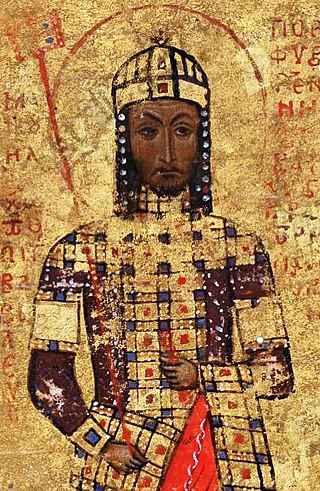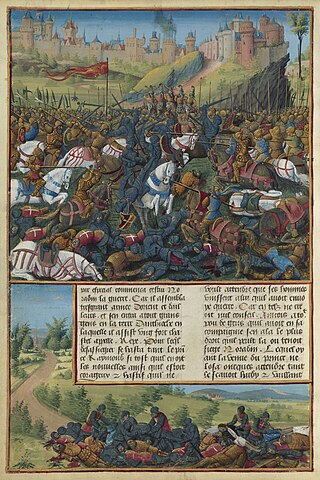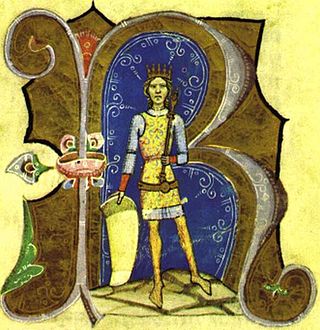Related Research Articles

William of Tyre was a medieval prelate and chronicler. As archbishop of Tyre, he is sometimes known as William II to distinguish him from his predecessor, William I, the Englishman, a former prior of the Church of the Holy Sepulchre, who was Archbishop of Tyre from 1127 to 1135. He grew up in Jerusalem at the height of the Kingdom of Jerusalem, which had been established in 1099 after the First Crusade, and he spent twenty years studying the liberal arts and canon law in the universities of Europe.

Manuel I Komnenos, Latinized as Comnenus, also called Porphyrogenitus, was a Byzantine emperor of the 12th century who reigned over a crucial turning point in the history of Byzantium and the Mediterranean. His reign saw the last flowering of the Komnenian restoration, during which the Byzantine Empire had seen a resurgence of its military and economic power and had enjoyed a cultural revival.

The Second Crusade (1147–1150) was the second major crusade launched from Europe. The Second Crusade was started in response to the fall of the County of Edessa in 1144 to the forces of Zengi. The county had been founded during the First Crusade (1096–1099) by King Baldwin I of Jerusalem in 1098. While it was the first Crusader state to be founded, it was also the first to fall.
William de Warenne, 3rd Earl of Surrey was an Anglo-Norman nobleman, member of the House of Warenne, who fought in England during the Anarchy and generally remained loyal to King Stephen. He participated in, and ultimately perished during, the Second Crusade.

The Battle of Harran took place on 7 May 1104 between the Crusader states of the Principality of Antioch and the County of Edessa, and the Seljuk Turks. It was the first major battle against the newfound Crusader states in the aftermath of the First Crusade, marking a key turning point against Frankish expansion. The battle had a disastrous effect on the Principality of Antioch as the Turks regained territory earlier lost.

The siege of Damascus took place between 24 and 28 July 1148, during the Second Crusade. It ended in a crusader defeat and led to the disintegration of the crusade. The two main Christian forces that marched to the Holy Land in response to Pope Eugene III and Bernard of Clairvaux's call for the Second Crusade were led by Kings Louis VII of France and Conrad III of Germany. Both faced disastrous marches across Anatolia in the months that followed, with most of their armies being destroyed. The original focus of the crusade was Edessa (Urfa), but in Jerusalem, the preferred target of King Baldwin III and the Knights Templar was Damascus. At the Council of Acre, magnates from France, Germany, and the Kingdom of Jerusalem decided to divert the crusade to Damascus.

Everard des Barres was the third Grand Master of the Knights Templar from 1147 to 1152.

The siege of Lisbon, from 1 July to 25 October 1147, was the military action against the Muslim-ruled Taifa of Badajoz that brought the city of Lisbon under the definitive control of the new Christian power, the Kingdom of Portugal.

Géza II was King of Hungary and Croatia from 1141 to 1162. He was the oldest son of Béla the Blind and his wife, Helena of Serbia. When his father died, Géza was still a child and he started ruling under the guardianship of his mother and her brother, Beloš. A pretender to the throne, Boris Kalamanos, who had already claimed Hungary during Béla the Blind's reign, temporarily captured Pressburg with the assistance of German mercenaries in early 1146. In retaliation, Géza, who came of age in the same year, invaded Austria and routed Henry Jasomirgott, Margrave of Austria, in the Battle of the Fischa.

The Battle of Harim (Harenc) was fought on 12 August 1164 at Harim, Syria, between the forces of Nur ad-Din, and a combined army from the County of Tripoli, the Principality of Antioch, the Byzantine Empire, and Armenia. Nur ad-Din won a crushing victory, capturing most of the leaders of the opposing army.
Sibylla of Anjou was a countess consort of Flanders as the wife of Thierry, Count of Flanders. She served as the regent of Flanders during the absence of her spouse from 1147 to 1149.

Frederick de la Roche was the sixth Latin archbishop of Tyre (1164–1174), chancellor of the kingdom of Jerusalem, and the chief diplomat of King Amalric. He was a Lorrainer, from the town of La Roche, of noble stock.
Odo of Deuil, his first name also spelled Odon, Eude or Eudes, was a French historian of and participant in the Second Crusade (1147–1149).

The second Battle of Dorylaeum took place near Dorylaeum in October 1147, during the Second Crusade. It was not a single clash but consisted of a series of encounters over a number of days. The German crusader forces of Conrad III were defeated by the Seljuk Turks led by Sultan Mesud I.

The Council of Acre met at Palmarea, near Acre, a major city of the crusader Kingdom of Jerusalem, on 24 June 1148. The Haute Cour of Jerusalem met with recently arrived crusaders from Europe, to decide on the best target for the crusade. The Second Crusade had been called after the fall of Edessa to Zengi in 1144. In 1147, armies led by Conrad III of Germany and Louis VII of France began their separate journeys to the east. Conrad arrived at Acre in April 1148, and Louis marched south from Antioch.
Boris, also known as Boris Kalamanos was a claimant to the Hungarian throne in the middle of the 12th century. He was the son of Euphemia of Kiev, the second wife of Coloman the Learned, King of Hungary. After Euphemia was caught in adultery, Coloman expelled her from Hungary and never acknowledged that he was Boris's father. However, Boris, who was born in the Kievan Rus', regarded himself as the king's lawful son. He laid claim to Hungary after Coloman's firstborn and successor, Stephen II of Hungary, died in 1131. Boris made several attempts to assert his claims against kings Béla II and Géza II with the assistance of Poland, the Holy Roman Empire and the Byzantine Empire, but failed and was killed in a battle.
Warner of Grez Count of Grez, was a French nobleman from Grez-Doiceau, currently in Walloon Brabant in Belgium. He was one of the participants in the army of Godfrey of Bouillon of the First Crusade, and died in Jerusalem a year after the crusade ended. His brother Henry is also listed as a Count of Grez and accompanied Warner on the First Crusade.

The Battle of Mount Cadmus took place near Laodicea, at Chonae, on 6 January 1148, during the Second Crusade. The French crusader army, led by Louis VII of France, was defeated by the Seljuks of Rum.
The Battle of Ephesus took place on 24 December 1147, during the Second Crusade. The French crusader army, led by Louis VII of France, successfully fended off an ambush by the Seljuks of Rum just outside the town of Ephesus.
Benedict was the first archbishop of Edessa of the Latin rite. He was probably appointed soon after Count Baldwin I founded the county of Edessa in 1098. He was consecrated by Patriarch Daimbert of Jerusalem in December 1099. He may have replaced a Byzantine bishop, if one was still in residence after the Byzantines lost the city in 1087. Although the highest-ranking churchman in the county of Edessa, Benedict was subordinated to the patriarch of Antioch in accordance with the 6th-century Notitiae episcopatuum. The contemporary historian William of Tyre calls Benedict, Daimbert and the Antiochene patriarch, Bernard, three "distinguished lights of the church".
References
- 1 2 3 Odo of Deuil, De profectione Ludovici VII in Orientem, tr. V.G. Berry (New York: W.W. Norton and Co., 1948), p. 111.
- ↑ Phillips, Jonathan, The Second Crusade: Extending the Frontiers of Christendom, (Yale University Press, 2007), p. 197.
- 1 2 Odo of Deuil, p. 113.
- ↑ William of Tyre, A History of Deeds Done Beyond the Sea, trans. E. A. Babcock and A. C. Krey (Columbia University Press, 1943), vol. 2, p. 175.
- ↑ Phillips, The Second Crusade, p. 198.